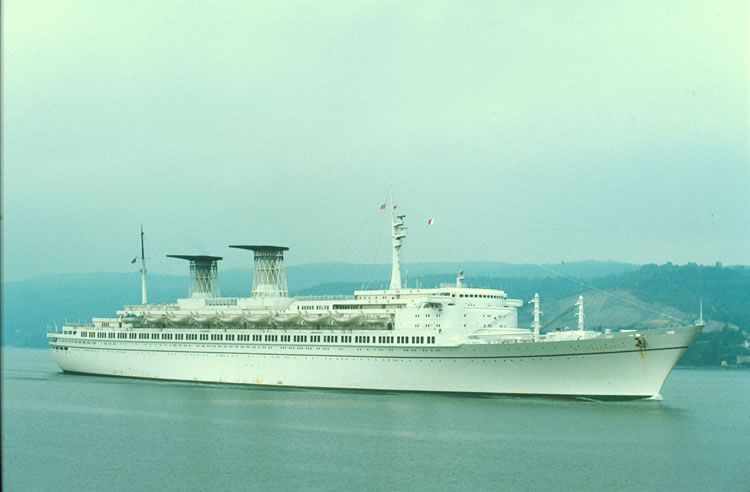T/S “Michelangelo” c/s ICVI
Dear Sparks,
thanks to some suggestions of our colleague R/O Riccardo MEMEO here is a piece of Italian story at sea.
At the end of the review there is a youtube promotional clips where at minute 8.15 it is showed the radio room of the ship, it is well known that on board the vessel there were transmitters of 5 kW power usually used in shore radio stations.
T/S Michelangelo was, together with Raffaello’s sister ship, the last transatlantic built for Società Italia. She remained in service for only ten years, from 1965 to 1975, before being disarmed because of the unsustainable economic losses of the transatlantic passenger service during the years. Sold to the Iranian government to be used as accommodation for officers and troops following the construction of the port of Bandar Abbas, she remained in a state of increasing abandonment until 1991, when, privately owned, superstructures were towed to Pakistan and scrapped.
Michelangelo and Raffaello’s twin were the result of the last plan to renew the fleet of passenger ships of Italian passengers companies, whose organization had undergone various changes following the devastation of World War II and the resumption of migration from Italy to United States of America, South America and Australia after the war.
In the mid-1950s, in the midst of an economic boom, the project of two twin units that could absorb traffic between Naples and New York had begun to emerge, as the flagships of the fleet in service at that time ‘Andrea Doria and Christopher Columbus’ needed the support of the old Saturnia and Vulcania motor vessels to meet the demand for transportation to North America.
Meanwhile, the migratory flow to North America was falling and the airplane’s competition began to become important, so that in 1958, just six years after the establishment of the first regular transatlantic flights, the new transport system surpassed transatlantics by number of passengers transported. The Italian government and the Italia Society, however, decided to continue with the realization of the two transatlantics twins, named Michelangelo and Raffaello. The building was entrusted to the Ansaldo shipyard of Genova Sestri and to the Cantieri Riuniti of the Adriatic in Trieste at the same time, with an order made on February 4, 1960. Both were made on an Ansaldo project.
Michelangelo and Raffaello’s twin were thought to be able to compete on all fronts with the best units in service at the time. Particularly cared was the safety on board, an aspect that was taken into account by Italia Society after the accusations suffered in the demise of Andrea Doria. The two new ships were able to float even after the flooding of three of her 17 watertight compartments (against the two planned by SOLAS in 1960) and had a very high metacentric height, a feature that greatly increased stability. Even hull dampers were larger than the SOLAS 1960 directives, while the engine compartment was divided into two separate watertight rooms: the starboard propeller engine was completely separate from the left propeller to which he was situated ahead.
Long 275.8 meters wide and 31, Michelangelo had a gross tonnage of 45,911 tons, twenty-two less than the twin, and a full load of 42,000 tons. She could maintain a service speed of 26.5 knots, allowing her to make the crossing from Gibraltar to New York in just five days. Michelangelo could carry 1,775 passengers, of which 535 were in first class, 550 in cabin class and 690 in tourist class. Each class had its own common spaces separated from the others and this was one of the causes of the lack of transatlantic transformation on a cruise ship, along with the lack of portholes in many cabins and the high operating costs determined by the large size and presence of two engine gears.
Characteristic features of Michelangelo and twin were the two funnels surrounded by special trellis structures: derived from an aerodynamic laboratory study of the Politecnico di Torino originally carried out for the twins of Lloyd Triestino : Guglielmo Marconi and Galileo Galilei. in order to avoid the relapse of fumes on the external bridges, which in those years were increasingly valued by the designers. The trellis structures surrounding the main structure had pure aesthetic function.
Here is the clip, the video is very old and comes from the archive of “Light National Institute”
73’s
webmaster
